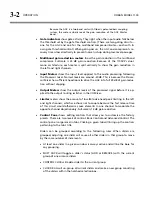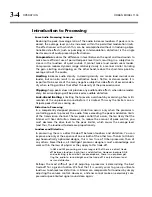
3-16
OPERATION
ORBAN MODEL 1100
have carefully designed OPTIMOD-PC’s factory presets and most users will not need
to go beyond these.
In OPTIMOD-PC, a processing structure is a program that operates as a complete au-
dio processing system. Only one processing structure can be active at a time. Just as
there are many possible ways of configuring a processing system using analog com-
ponents (like equalizers, compressors, limiters, and clippers), OPTIMOD-PC’s DSP
hardware realizes two processing structures that run simultaneously, permitting
graceful switching between them. Unlike an analog system, where creating a com-
plete processing system involves physically wiring its various components together,
OPTIMOD-PC realizes its processing structures as a series of high-speed mathematical
computations made by Digital Signal Processing (DSP) integrated circuit chips.
There are two basic structures:
Two-Band
and
Five-Band
, both of which are phase-
linear. To select a structure, choose a factory preset having the desired structure,
and, if you wish, edit it to create a user preset. To put a given structure on the air,
recall a factory or user preset associated with that structure.
Five-Band:
The Five-Band structure is very flexible, enabling you to fine-tune your
sound. There are several basic Factory Presets for the Five-Band structure. Each of
these presets can be edited with the L
ESS
-M
ORE
control.
This control affects the video-oriented presets differently than it does the music pre-
sets. When a video-oriented preset is on the air, the L
ESS
-M
ORE
control adjusts the
average amount of gain reduction by adjusting the drive level to the Five-Band
structure's input. This also adjusts the
idle gain—
the amount of gain reduction in
the AGC section when the structure is gated. (It gates whenever the input level to
the structure is below the user-adjustable threshold of gating.)
When a music preset is on the air, the L
ESS
-M
ORE
control sets the amount of overall
processing, making optimum tradeoffs between loudness, brightness, and distor-
tion. In sound for picture, there are no loudness wars; for music presets, there is
probably never a need to advance the L
ESS
-M
ORE
control beyond 5.
The stereo enhancer, AGC, equalizer, and look-ahead limiter are common to both
Two-Band and Five-Band processing and therefore stay the same when OPTIMOD-PC
switches between two-band and five-band operation. However, different controls
appear in the screens containing dynamics processing controls, as appropriate for
Two-Band or Five-Band multiband compression. The meters also change, displaying
the Two-Band or Five-Band gain reduction as appropriate.
The Two-Band and Five-Band multiband compressors are always running. Switching
between Two-Band and Five-Band therefore occurs with an cross-fade. Even though
no audio mute occurs, switching still can sound obtrusive if the loudness normally
produced by the two-band and five-band presets are very different. It is usually pos-
sible to eliminate audibly obtrusive switching artifacts by tweaking one (or both) of
the presets to make them sound closer to each other and saving the results as user
presets.
Содержание OPTIMOD-PC 1100
Страница 1: ...Operating Manual OPTIMOD PC 1100 Digital Audio Processor on a PCI Sound Card Software Version 2 0...
Страница 4: ......
Страница 5: ...Operating Manual OPTIMOD PC 1100 Digital Audio Processor on a PCI Sound Card Software Version 2 0...
Страница 18: ......
Страница 54: ......
















































